PORSCHE 911 CARRERA 2010 5.G Owners Manual
Manufacturer: PORSCHE, Model Year: 2010, Model line: 911 CARRERA, Model: PORSCHE 911 CARRERA 2010 5.GPages: 310, PDF Size: 3.39 MB
Page 261 of 310
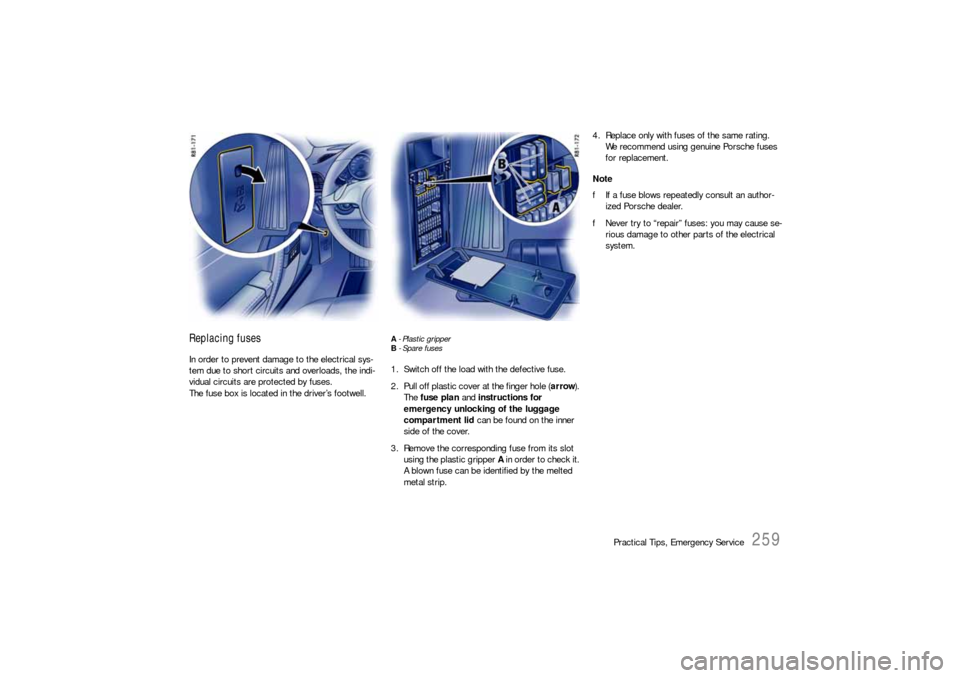
Practical Tips, Emergency Service
259
Replacing fuses In order to prevent damage to the electrical sys-
tem due to short circuits and overloads, the indi-
vidual circuits are protected by fuses.
The fuse box is located in the driver’s footwell.
A - Plastic gripper
B - Spare fuses 1. Switch off the load with the defective fuse.
2. Pull off plastic cover at the finger hole (arrow).
The fuse plan and instructions for
emergency unlocking of the luggage
compartment lid can be found on the inner
side of the cover.
3. Remove the corresponding fuse from its slot
using the plastic gripper A in order to check it.
A blown fuse can be identified by the melted
metal strip.4. Replace only with fuses of the same rating.
We recommend using genuine Porsche fuses
for replacement.
Note
fIf a fuse blows repeatedly consult an author-
ized Porsche dealer.
fNever try to “repair” fuses: you may cause se-
rious damage to other parts of the electrical
system.
Page 262 of 310
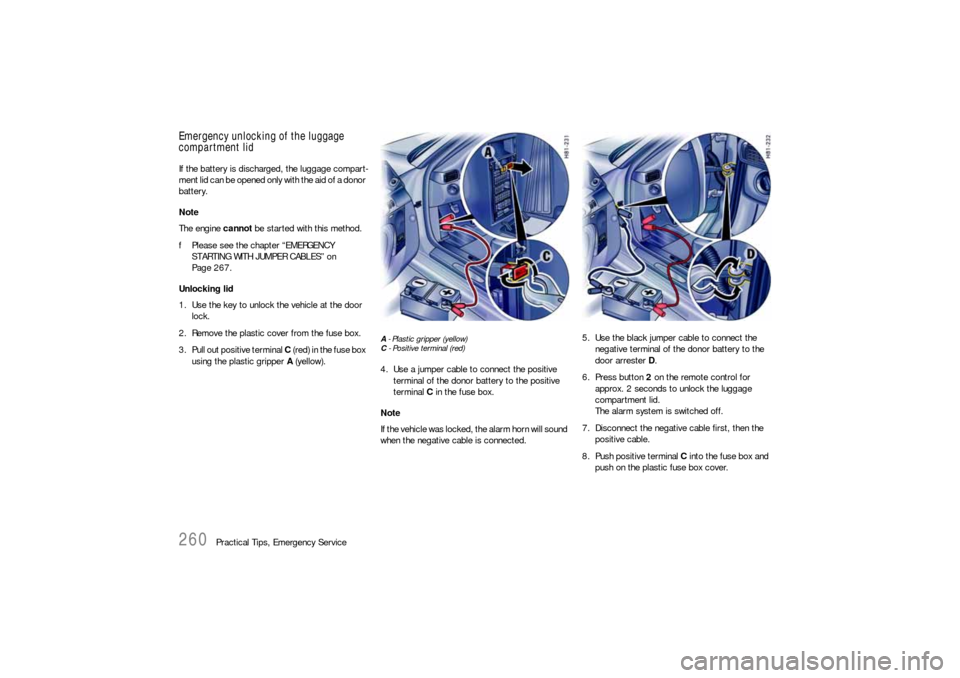
260
Practical Tips, Emergency Service
Emergency unlocking of the luggage
compartment lidIf the battery is discharged, the luggage compart-
ment lid can be opened only with the aid of a donor
battery.
Note
The engine cannot be started with this method.
fPlease see the chapter “EMERGENCY
STARTING WITH JUMPER CABLES” on
Page 267.
Unlocking lid
1. Use the key to unlock the vehicle at the door
lock.
2. Remove the plastic cover from the fuse box.
3. Pull out positive terminal C (red) in the fuse box
using the plastic gripper A (yellow).
A - Plastic gripper (yellow)
C - Positive terminal (red)4. Use a jumper cable to connect the positive
terminal of the donor battery to the positive
terminal C in the fuse box.
Note
If the vehicle was locked, the alarm horn will sound
when the negative cable is connected.
5. Use the black jumper cable to connect the
negative terminal of the donor battery to the
door arrester D.
6. Press button 2 on the remote control for
approx. 2 seconds to unlock the luggage
compartment lid.
The alarm system is switched off.
7. Disconnect the negative cable first, then the
positive cable.
8. Push positive terminal C into the fuse box and
push on the plastic fuse box cover.
Page 263 of 310

Practical Tips, Emergency Service
261
Battery The battery is located in the luggage compart-
ment under a black plastic cover.
fPlease see the chapter “EMERGENCY OPERA-
TION – PULLING OUT THE IGNITION KEY” on
Page 76.
fPlease see the chapter “EMERGENCY UNLO-
CKING OF THE LUGGAGE COMPARTMENT LID”
on Page 260.
Warning!
Risk of short circuit, fire and damage to al-
ternerator and electronic control units, re-
sulting in serious personal injury or death.
fObserve all warning notes on the battery.
fDisconnect the negative terminal on the bat-
tery during all work on the electrical system.
fDo not lay tools or other metal objects on the
battery as they could cause a short circuit
across the battery terminal.
Hydrogen gas generated by the battery
could cause an explosion, resulting in
serious personal injury or death.
fDo not expose the battery to an open flame,
electrical spark or a lit cigarette.
fDo not wipe battery with a dry cloth.
Risk of serious personal injury or death and
damage to the fabric, metal or paint. fWear eye protection.
fDo not allow battery acid to come in contact
with your skin, eyes, fabric or painted
surfaces.
fIf you get electrolyte, which is an acid, in your
eyes or on your skin, immediately rinse with
cold water for several minutes and call a doc-
tor.
fSpilled electrolyte must be rinsed off at once
with a solution of baking soda and water to
neutralize the acid.
Battery posts, terminals and related acces-
sories contain lead and lead compounds,
chemicals known to the State of California to
cause cancer and reproductive harm.
fAlways protect your skin by washing thorough-
ly with soap and water.
Risk of explosion as a result of static charge,
resulting in serious personal injury or death.
fDo not wipe the battery with a dry cloth.
fEliminate potential electrostatic charge by
touching the vehicle before touching the bat-
tery.
Charge state A well-charged battery prevents starting problems
and has a longer service life.
Traffic density, requirements regarding noise, ex-
haust gas and fuel consumption reduce the engine
speed and, hence, the alternator output.
However, the large number of electrical loads has
markedly increased the demand for electrical
power.
In order to avoid discharging the battery
unintentionally:
fSwitch off unnecessary electrical loads in city
traffic, on short trips or in a line or traffic.
fAlways remove the ignition key from the igni-
tion switch when leaving the car.
fAvoid frequent operation of the convertible top
and operation of the Porsche Communication
Management system when the engine is not
running.
fIn the cold season in particular or if the vehicle
is used primarily for short journeys, it may be
necessary to recharge the battery from time to
time.
Page 264 of 310

262
Practical Tips, Emergency Service
Battery care fEnsure that battery is securely mounted.
fKeep terminals and connections clean and
properly tightened.
Corrosion can be prevented by coating the ter-
minals and connections with petroleum jelly or
silicone spray.
fEnsure that vent caps are securely tightened to
prevent spillage. Checking the electrolyte fluid level
The acid level should be checked more frequently
by a qualified specialist workshop during the sum-
mer months and in predominantly warm countries.
Battery charging
Automotive batteries loose their efficiency when
not in use.
The charge available in your battery can be meas-
ured with a battery hydrometer.
We recommend that the battery voltage be tested
by your authorized Porsche dealer who has the ap-
propriate equipment.
If the car is not driven for prolonged periods, the
battery must be charged at least every 6 weeks.
A discharged battery allows rapid formation of sul-
fates, leading to premature deterioration of the
plates.
Warning!
Hydrogen gas generated by the battery
could cause an explosion, resulting in
serious personal injury or death.
fCharge battery in a well ventilated area.
fNever charge a frozen battery. It may explode
because of gas trapped in the ice. Allow a fro-
zen battery to thaw out first.
fIf you get electrolyte, which is an acid, in your
eyes or on your skin, immediately rinse with
cold water for several minutes and call a doc-tor. Slow battery charging
Your authorized Porsche dealer will be pleased to
advise you about a suitable charger.
1. Always observe the instructions of the charger
manufacturer.
Depending on the type of charger, the battery
may have to be disconnected.
In this case, always disconnect the negative
lead first, and then the positive lead – risk of
short circuit!
Reconnect the leads in reverse order.
2. Before charging, cold batteries must be
warmed up indoors.
3. Frozen batteries must be thawed out first
before being charged.
4. When charging, ensure that there is adequate
ventilation.
5. Connect the charger to the battery.
Only plug into the mains and switch the
charger on when it is connected up correctly.
6. Switch on the charger.
7. After charging, switch off the charger first and
then disconnect it.
fPlease see the chapter “PUTTING VEHICLE
INTO OPERATION” on Page 263.
Page 265 of 310

Practical Tips, Emergency Service
263
Winter operation The capacity and ability of the battery to store
power decreases at low outside temperatures.
Moreover, the battery is more heavily loaded in
winter months, e.g. by the heated rear window,
more frequent use of additional lights, the fans
and the windshield wipers, etc.
fHave the battery checked before the start of
winter.
Maintenance note
Keep the battery well charged to prevent it
from freezing.
A discharged battery can freeze at 23 °F (--5 °C),
but a fully charged battery only freezes at -- 40 °F
(--40 °C).
A frozen battery must always be thawed before
connecting jump leads.
Replacing battery The service life of the battery is subject to normal
wear; it depends greatly on care, climatic condi-
tions, and driving conditions (distances, loads).
fOnly use an original Porsche battery, with the
correct part number, as a replacement.
fPlease observe the disposal instructions for
batteries.
Putting vehicle into operationAfter the battery is connected or after an exhaus-
tively discharged battery is charged, the multi-
functional PSM light lights up on the instrument
panel and a message appears on the on-board
computer to indicate a fault.
This fault can be remedied with a few simple
steps:
1. Start the engine.
2. With the vehicle stationary, perform a few
steering movements to the left and right and
then drive a short distance in a straight line
until the multifunctinal PSM light goes out and
the message on the on-board computer
disappears.
3. If the warnings do not disappear, then:
Drive carefully to the nearest authorized
Porsche dealer.
Have the fault remedied.
4. After the warnings disappear:
Stop the vehicle in a suitable place.
fPerform adaptation of the power windows:
Please see the chapter “STORING END
POSITION OF THE WINDOWS” on Page 26.
Page 266 of 310
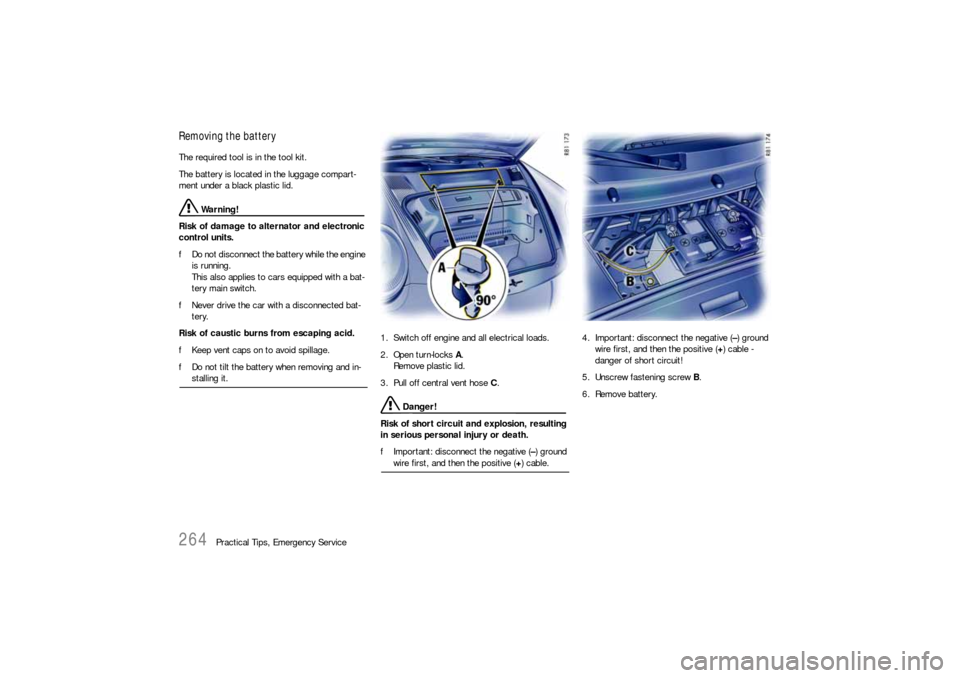
264
Practical Tips, Emergency Service
Removing the battery The required tool is in the tool kit.
The battery is located in the luggage compart-
ment under a black plastic lid.
Warning!
Risk of damage to alternator and electronic
control units.
fDo not disconnect the battery while the engine
is running.
This also applies to cars equipped with a bat-
tery main switch.
fNever drive the car with a disconnected bat-
tery.
Risk of caustic burns from escaping acid.
fKeep vent caps on to avoid spillage.
fDo not tilt the battery when removing and in-stalling it. 1. Switch off engine and all electrical loads.
2. Open turn-locks A.
Remove plastic lid.
3. Pull off central vent hose C.
Danger!
Risk of short circuit and explosion, resulting
in serious personal injury or death.
fImportant: disconnect the negative (–) ground wire first, and then the positive (+) cable.4. Important: disconnect the negative (–) ground
wire first, and then the positive (+) cable -
danger of short circuit!
5. Unscrew fastening screw B.
6. Remove battery.
Page 267 of 310
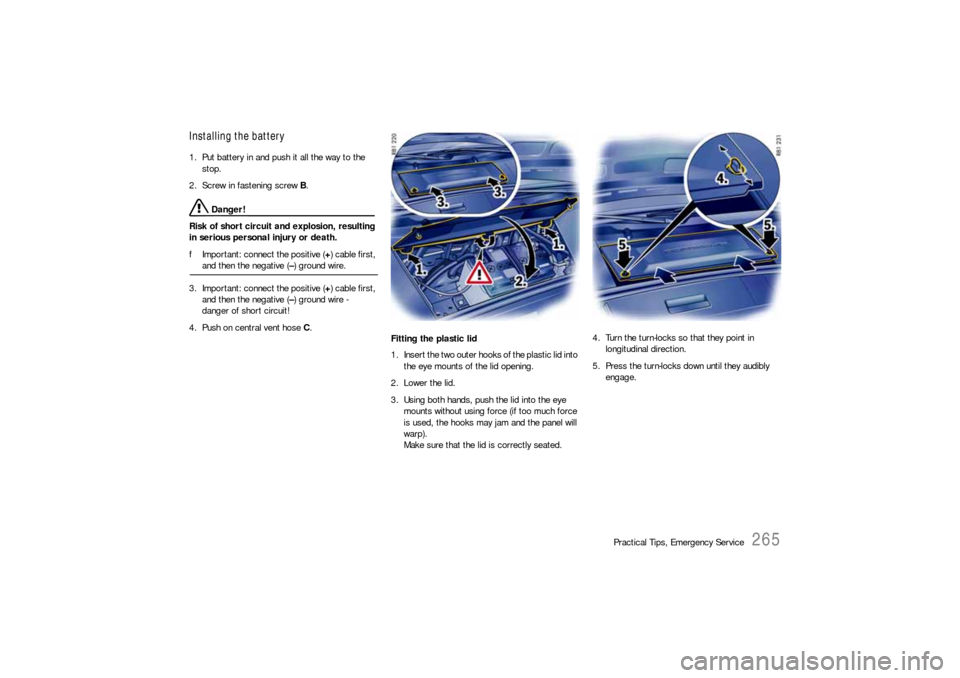
Practical Tips, Emergency Service
265
Installing the battery 1. Put battery in and push it all the way to the
stop.
2. Screw in fastening screw B.
Danger!
Risk of short circuit and explosion, resulting
in serious personal injury or death.
fImportant: connect the positive (+) cable first, and then the negative (–) ground wire.
3. Important: connect the positive (+) cable first,
and then the negative (–) ground wire -
danger of short circuit!
4. Push on central vent hose C.
Fitting the plastic lid
1. Insert the two outer hooks of the plastic lid into
the eye mounts of the lid opening.
2. Lower the lid.
3. Using both hands, push the lid into the eye
mounts without using force (if too much force
is used, the hooks may jam and the panel will
warp).
Make sure that the lid is correctly seated.4. Turn the turn-locks so that they point in
longitudinal direction.
5. Press the turn-locks down until they audibly
engage.
Page 268 of 310
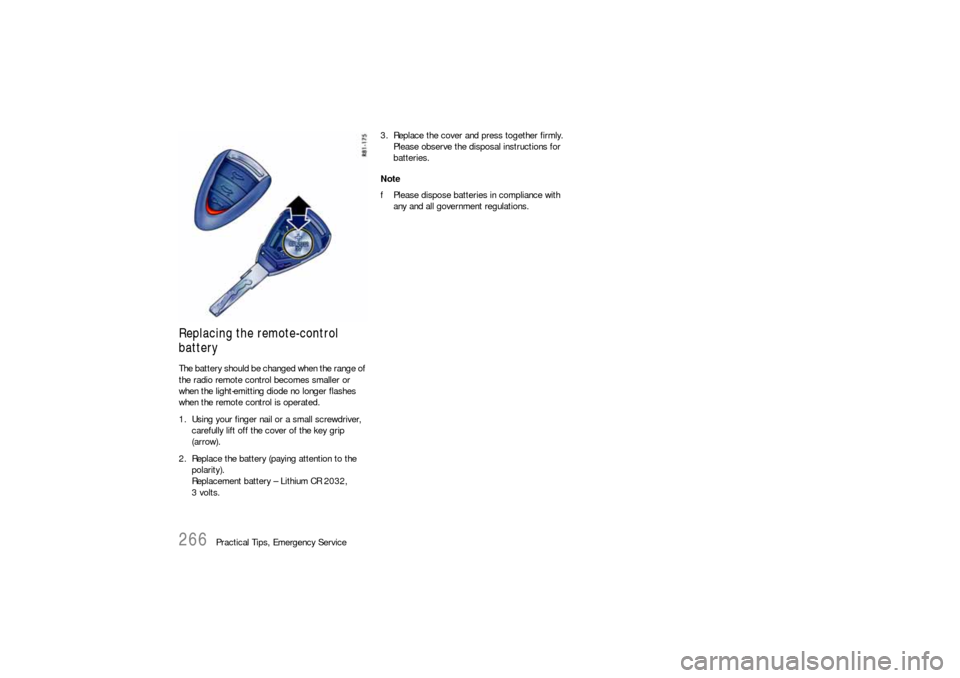
266
Practical Tips, Emergency Service
Replacing the remote-control
battery The battery should be changed when the range of
the radio remote control becomes smaller or
when the light-emitting diode no longer flashes
when the remote control is operated.
1. Using your finger nail or a small screwdriver,
carefully lift off the cover of the key grip
(arrow).
2. Replace the battery (paying attention to the
polarity).
Replacement battery – Lithium CR 2032,
3volts.3. Replace the cover and press together firmly.
Please observe the disposal instructions for
batteries.
Note
fPlease dispose batteries in compliance with
any and all government regulations.
Page 269 of 310
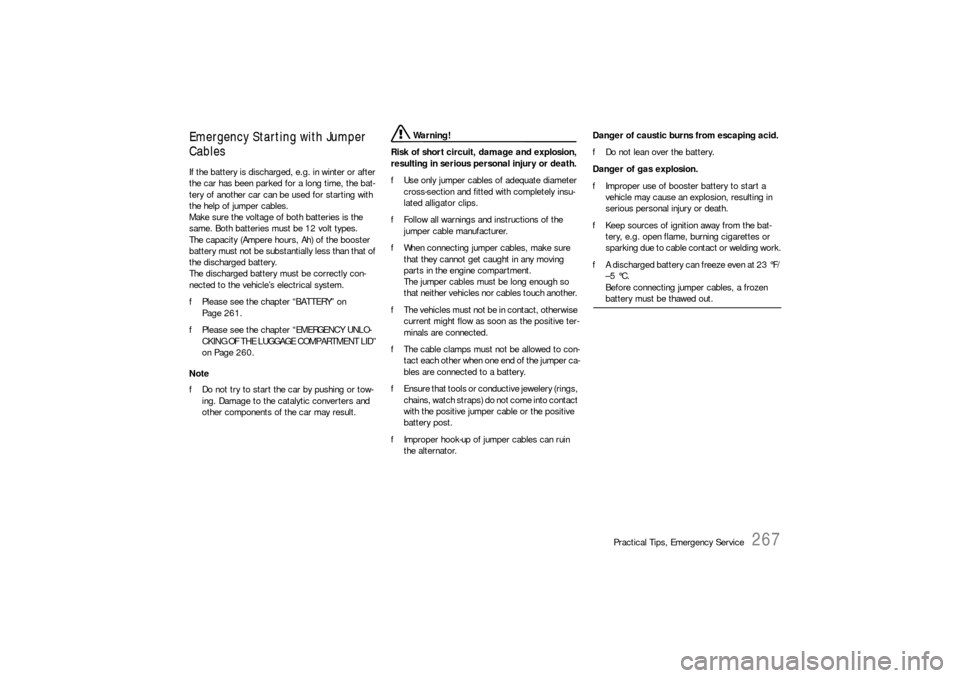
Practical Tips, Emergency Service
267
Emergency Starting with Jumper
Cables If the battery is discharged, e.g. in winter or after
the car has been parked for a long time, the bat-
tery of another car can be used for starting with
the help of jumper cables.
Make sure the voltage of both batteries is the
same. Both batteries must be 12 volt types.
The capacity (Ampere hours, Ah) of the booster
battery must not be substantially less than that of
the discharged battery.
The discharged battery must be correctly con-
nected to the vehicle’s electrical system.
fPlease see the chapter “BATTERY” on
Page 261.
fPlease see the chapter “EMERGENCY UNLO-
CKING OF THE LUGGAGE COMPARTMENT LID”
on Page 260.
Note
fDo not try to start the car by pushing or tow-
ing. Damage to the catalytic converters and
other components of the car may result.
Warning!
Risk of short circuit, damage and explosion,
resulting in serious personal injury or death.
fUse only jumper cables of adequate diameter
cross-section and fitted with completely insu-
lated alligator clips.
fFollow all warnings and instructions of the
jumper cable manufacturer.
fWhen connecting jumper cables, make sure
that they cannot get caught in any moving
parts in the engine compartment.
The jumper cables must be long enough so
that neither vehicles nor cables touch another.
fThe vehicles must not be in contact, otherwise
current might flow as soon as the positive ter-
minals are connected.
fThe cable clamps must not be allowed to con-
tact each other when one end of the jumper ca-
bles are connected to a battery.
fEnsure that tools or conductive jewelery (rings,
chains, watch straps) do not come into contact
with the positive jumper cable or the positive
battery post.
fImproper hook-up of jumper cables can ruin
the alternator. Danger of caustic burns from escaping acid.
fDo not lean over the battery.
Danger of gas explosion.
fImproper use of booster battery to start a
vehicle may cause an explosion, resulting in
serious personal injury or death.
fKeep sources of ignition away from the bat-
tery, e.g. open flame, burning cigarettes or
sparking due to cable contact or welding work.
fA discharged battery can freeze even at 23 °F/
–5 °C.
Before connecting jumper cables, a frozen
battery must be thawed out.
Page 270 of 310

268
Practical Tips, Emergency Service
Connect jumper cables in the following
sequence: Always observe the sequence below:
1. Connect the positive lead (red) to the
positive terminal of the discharged battery
first, then connect it to the positive terminal of
the donor battery.
2. First connect the negative cable (black) to
the negative terminal of the donor battery, then
connect it to a suitable grounding point on the
vehicle with the discharged battery.
This grounding point must lie as far as possible
from the battery.
For example, a solid metal part or the engine
block are suitable grounding points.
If no suitable grounding points are to be found
on either vehicle, the negative cable must
carefully be connected directly to the negative
terminal of the battery.
If a suitable grounding point is to be found only
on the donor vehicle, the negative cable must
first be connected to the terminal of the
discharged battery, then to the grounding point
of the donor vehicle.
3. Run the engine of the donor car at a higher
speed.4. Start the engine.
An attempted start using jumper cables should
not last more than 15 seconds. Then allow a
waiting period of at least one minute.
fNote
Before disconnecting the jumper cables, elec-
trical loads such as the heated rear window
and the heating fan blower should be switched
on (the vehicle’s lights must not be switched
on). This reduces voltage peaks which may oc-
cur when disconnecting the jumper cables.
With the engine running, remove both jumper
cables in reverse order.